|
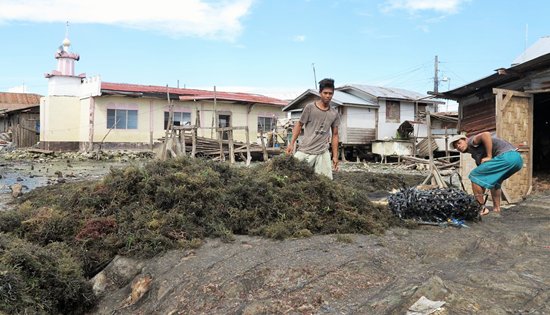
Though
most displaced people in Zamboanga City have since moved on with
their lives, recovery is progressing slowly for about 17,000 of
them living in 12 transition sites. Here, two men prepare to dry
seaweed - a source of income - in Taluksangay transition site.
(By NC-ND / ICRC /R. Ang) |
Moving on in
Zamboanga
By
ICRC
November 30, 2015
MANILA – Zamboanga City, in Western Mindanao, is buzzing with life
again, two years after armed fighting disrupted many lives.
Around 120,000 people were displaced by clashes in Zamboanga in
September 2013. Thousands of structures, including many houses, were
damaged or destroyed, making life extremely difficult for the affected
communities.
Though most displaced people have since moved on with their lives,
recovery is progressing slowly for about 17,000 of them living in 12
transition sites. Although these sites offer slightly better
conditions than evacuation centers, access to clean water, sanitation,
and livelihood opportunities remains a concern.
"Civilians unfortunately bear the heaviest consequences of conflict,
and the situation in Zamboanga was no exception," said Marcel
Goyeneche, head of the ICRC office in Zamboanga. "Thousands of
displaced families had lost their homes and jobs. The slow pace of the
response and the recovery had us extend our operations several times
to a total of 26 months."
After providing assistance in the immediate aftermath of the siege,
the ICRC together with the Philippine Red Cross (PRC) extended their
support to speed up the recovery of the affected population. Below is
a glimpse of how these programs helped the displaced from January to
October 2015.
Ensuring clean water and proper sanitation
Due to water-supply issues generally affecting Zamboanga City, the
ICRC and the PRC trucked 36,000 liters of water daily to four
transition sites from February until August 2015. The ICRC still
supports the city government and the Zamboanga Water District in
providing water storage to displaced people in Masepla 1, 2, and 3 and
in Rio Hondo through the installation of six 10,000-liter stainless
steel tanks. Upon the request of city authorities, the ICRC also
installed a 10,000-liter bladder in Lupa-lupa.
In Taluksangay, the ICRC helped provide a longer-term solution by
building a permanent water supply system at the transition site to
serve both the displaced and resident populations. Water started
flowing in September, and eventually the project was handed over to
the community's water association, which was formed to operate and
maintain the project. More than 4,000 people, around 900 of whom are
displaced, from Purok 4 of Taluksangay now have regular access to
clean water.
"We used to struggle every day to find safe drinking water. But now
we've seen how the water supply here in Taluksangay normalized," said
Jurraiya Abdurajik, 37, who was displaced from Rio Hondo. "Our family
now feels protected from waterborne illnesses."
Four hand pumps will also be installed in the Masepla 3 transition
site, where around 7,700 displaced people will benefit upon the
project's completion in December. In addition, rainwater drainage will
improve the road access to Masepla 1.
To improve sanitation, the 102 latrines built in the Joaquin Enriquez
stadium and in the Rio Hondo site were regularly emptied until August.
Complementary to these projects, informative sessions on the
importance of hygiene were held, benefiting 13,300 displaced persons;
and around 1,500 hygiene kits were given to children in transitory
daycare centers.
Rebuilding livelihoods' and communities
With livelihoods disrupted by the conflict, helping displaced people
stand on their own feet was part of the ICRC's efforts. From January
to October 2015, cash-for-work activities not only generated income
for at least 820 of them but also benefited 14 community projects
including desilting of canals and improving drainage systems,
beautification and gardening, repairing chapels, mangrove planting,
and coastal clean-up.
Conditional cash grants, meanwhile, have also helped displaced
families to achieve a more sustainable form of livelihood. Some 840
families in seven transition sites received P10,000 grants each that
were used to restock sari-sari stores, build boats, buy fishing gear
and inputs for planting seaweed, procure sewing machines and
tricycles, among others.
"I used the cash incentives to start my hairdressing business. Now
life has become easier because my income can sustain my daily needs,"
said Borhan Vivio, 35, of the Kasanyangan transition site.
In Layag Layag, a 50-member cooperative benefited from a cash grant
and training to help them plant and commercialize seaweed. This
included the construction of a boat and a storage facility to support
the members of the cooperative. Two concrete solar stilt driers were
also built through cash-for-work thus providing a facility for the
community's use, and providing income for 120 seaweed farmers.
Improving health care and nutrition
Access to health care could also be difficult for those living in
transition sites. At the Masepla transition site, where a new health
station was built and handed over to the City Health Office (CHO) in
April 2015, displaced people no longer have to travel 2 kilometers to
the health centre in Barangay Mampang to avail of primary health care
services.
In addition, to ensure their preparedness for emergencies and other
health issues, 40 displaced people from different sites underwent
Community-based First Aid Training, also in April, so they could serve
as their communities' focal points.
The ICRC also continues to support local authorities and
infrastructure in their nutrition and health programs for the
displaced.
An example is the feeding program that started in 2014 but has been
turned over to the City Health Office as of June 2015 due to the
improvement in malnutrition rates. The ICRC provides supplies to the
CHO for both severely and moderately malnourished children in
transition sites and in barangays with a high number of malnourished
children.
An estimated 661 children with moderate to severe malnourishment
benefited from this program from January to September 2015.
The Zamboanga City Medical Center has also received support from the
ICRC since 2014 in the form of essential medicines for the treatment
of displaced and other vulnerable people. This quarterly support will
continue in 2016.
Challenges remain
After more than two years, the ICRC will be phasing out its assistance
program to the displaced population in Zamboanga by January 2016, as
local authorities address the remaining needs.
"Although we are concluding our support to people displaced in 2013,
we will pursue a dialogue with authorities to find safe and dignified
solutions for the displaced," said Goyeneche. "Their move to permanent
shelters must also be addressed quite soon."
The ICRC remains close to the population through its office in
Zamboanga, and stands ready to assist in humanitarian emergencies
together with the PRC.
The ICRC, which has been visiting people detained in relation to the
internal armed conflicts, will carry on its work to ensure the
inmates' dignified treatment and that they maintain links with their
families. It will also continue promoting awareness of and respect for
international humanitarian law among weapon bearers.
|
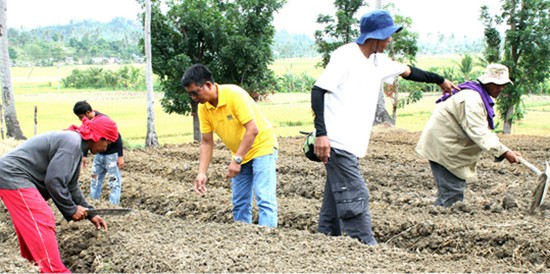
RESTORING
LIVELIHOODS. Local farmers in Brgy. Inangatan, Tabango, Leyte
receive proper training on farming preparations. |
Super typhoon Yolanda’s
second anniversary
PBSP celebrates the resilience of survivors and the power of
collective action
By
PBSP
November 6, 2015
MANILA – Two years after
super typhoon Yolanda (Haiyan) ravaged the Visayas region, many of the
survivors are still picking up the pieces of their lives which were
severely disrupted by one of the world’s strongest tropical cyclones.
But there are also a number
of them that have recovered significantly through local and
international aid. With the continuous assistance from development
agencies and NGOs like Philippine Business for Social Progress (PBSP),
other survivors even feel that their situation is now better than
before.
In A Better State
Take the case of Merle
Tabornal and Gina Ciudad of Brgy. Tubogan in Ajuy, Iloilo, for
instance, who used to walk seven kilometers (equivalent to three
barangays) just to receive free pre-natal care at the only barangay
health station (BHS) in the municipality. A BHS was built in Tubogan
in 2008 but only to be damaged by the typhoon five years after. Months
after the typhoon, their community of 739 rice and corn farmers
continued to rely on the run-down BHS and struggled to make its
operations normal despite the challenges.
Now, they are enjoying the
benefits of improved healthcare services and a better health station
which has a new roof, newly-painted walls, a sturdier ceiling, and a
complete set of windows, gutters, and doors. Through this project of
Asalus Corporation and PBSP, barangay health workers were also trained
on Integrated Management of Childhood Illness which equipped them to
better manage diagnosis and treatment of common illnesses of children.
The community is now working together to upgrade their BHS into a
birthing facility.
Panalaron Central Elementary
School (PCES) was among the severely damaged schools in Tacloban City,
Leyte which was badly hit by typhoon Yolanda on Nov. 8, 2013. Most of
its students lost their drive to attend classes because they did not
have classrooms, facilities and even school supplies. Grade 4 student Ranzelle Ann Sombrero could not attend her classes regularly because
of poor health, family problems, and lack of food. Nine-year-old
Marivic Balais also suffered the same problems.
Fortunately, their situation
changed when Mondelez Philippines, together with PBSP, stepped in and
chose PCES as its 6th adopted school under its Joy Schools Program.
Mondelez Philippines improved the nutrition and academic performance
of the students through the rehabilitation of 18 classrooms,
playground and canteen, regular feeding sessions of 150 severely
wasted students for one year, construction of library and reading
corners, provision of school equipment such as overhead projectors,
DVD players and speakers.
After a year under the
feeding program, Sombrero has not only improved her health but is now
an honor student. For Balais, the feeding program has helped
contribute to her total development and resulted in her getting
accelerated to the third grade. These interventions had a similar
effect on many other students in PCES which is fast transforming into
an ideal school for the Taclobanons.
Patrocinia Oftana of Sitio
Matab-ang in Madridejos, Cebu, used to spend at least P50 a day just
for water supply. She would pay a man to fetch her two 1.5 liters of
water in the nearest dug well which was three kilometers from her
home. She used the water for bathing, washing clothes and dishes, and
for gardening. For her family’s drinking water, she pays the same man
to purchase five gallons of water for their monthly consumption.
Sometimes, she does not take a bath for days just to save water.
For years, this has been the
situation of 6,000 families in 14 barangays on Bantayan island who
relied on the 200 remote dug wells for their water usage. When the
typhoon hit the island and made distribution from deep wells even
scarcer, they had to go back to the man-made dug wells despite threats
of water-borne diseases.
But their plight improved
when Mercury Drug Foundation, in partnership with PBSP, installed
level 2 and 3 potable water systems to 772 households. The project
provided materials and labor needed by the barangays to connect the
Madridejos Community Waterworks System’s main lines to three interior
and waterless barangays.
Oftana and several of her
fellow residents can now access water anytime they want through their
own faucets, and only pay a monthly fee of P100 for 10 cubic meters of
usage.
Farmer Romulo dela Peza has
been depending on the coconut plantations in Brgy. Inangatan, Leyte to
support his family. But when the farm where he worked was destroyed by
Typhoon Yolanda, the now 66-year-old copra producer was left out of
work and without a house.
Out of the 10,000 coconut
trees on the plantation where dela Peza works, 7,000 were lost and the
rest were left in an unproductive state. Some trees eventually died
even after initially showing signs of recovery. It all seemed hopeless
until Cargill Philippines and PBSP extended a helping hand to recover
and rehabilitate the damaged coconut plantations.
Through intercropping, his
participation in the Cash for Work program, and his work as the lead
in the rehabilitation of the coconut plantation, dela Peza does not
only have a new house, he also earns as much as P8,000 a month – so
much more than the meager P1,000 that he got before the storm. He is
just among the 204 other household farmers who greatly benefited from
the coconut recovery and rehabilitation project.
A Disaster of Huge Proportions
Typhoon Yolanda affected 14
million people in the Visayas region. Of this, 5.9 million workers
lost their jobs, resulting to an income loss of up to 70 percent in
the affected communities. According to the Department of Education,
close to 4,600 classrooms were totally destroyed. Poultry and
livestock perished. Agricultural lands were turned into wastelands as
crops were heavily damaged. Basic necessities such as water and health
services were also interrupted, leaving survivors helpless and
hopeless.
PBSP raised an initial P18.3
million from its own network of corporations, individual sponsors and
international funding groups for relief missions. It distributed
relief goods, hygiene kits, comfort bundles, kitchen utensils, and
shelter repair materials to more than 20,000 households in 14
municipalities in Cebu, Samar and Leyte.
Project New Dawn
But the damages wrought by
the typhoon continued to pose bigger challenges for the affected
communities. Hence, PBSP launched Project New Dawn in June 2014 to
provide long-term rehabilitation interventions focused on health,
education, environment and livelihood and enterprise development.
It raised P293 million from
its member-companies, partners and donors for the implementation of
many projects in the affected communities. Of this, P160 million had
been spent for projects in the least assisted towns in Bantayan,
Madridejos, Santa Fe, and Daanbantayan in Northern Cebu. After several
months, PND expanded its assistance to Iloilo, Samar, and Leyte.
Asalus Corporation rebuilt
three rural health stations in Ajuy, loilo and Daanbantayan, Cebu.
PBSP had also built 31 disaster-resilient school buildings with help
from the following donors: Ace Foundation International, Coca-Cola
Foundation Philippines, CTBC Bank (Philippines) Corporation, Deloitte
Philippines Outreach, Inc., Epson Precision Philippines, Inc., Insular
Life Foundation, Intel Foundation, L’Oreal Philippines, Inc., Telus
International Philippines, Inc. and Mondelez Philippines. The
buildings now provide a better and safer learning haven for the
children.
Mondelez Philippines, Fluor
Daniel, Inc.-Philippines and Lear Corporation also conducted
supplemental feeding programs and provided uniforms and starter kits
for teachers.
Donors from online platform
Global Giving with member-company Parity Values, Inc. helped plant
480,000 mangroves in 48 hectares in Northern Cebu. This project aims
to secure a brighter future for fishermen in the coming years.
The potable water system
projects of Mercury Drug Corporation and Dow Chemical through United
Way Worldwide helped bring safe drinking water directly to 1,582
households in 17 barangays.
PBSP helped families regain
their income and become more self-sufficient through livelihood
projects. First, the basic tools were provided: boats and fishing
gears for fishermen; farming tools, livestock and seeds for farmers;
and loans and retail items for sari-sari store (small retail store)
owners.
With the International
Rescue Committee (IRC) and the Adventist Development and Relief Agency
(ADRA), PBSP has helped establish sustainable ways of fishing in Panay
and Iloilo by setting up 23 local fish-enhancing devices and
installing 1,600 artificial reefs. Workers were hired in the various
construction requirements of livelihood projects so they can earn more
income. Mothers were provided with bio-intensive garden kits
containing basic vegetables, fertilizers and tools so they can get
additional food from their own backyards.
Local economies in Leyte
were also revitalized. PBSP and Hapinoy’s Project Bagong Araw enabled
79 sari-sari store owners to receive capital loans, store makeovers
and trainings on business skills.
Building Partnerships for Collective Action
While many have already
rebuilt their lives, PBSP recognizes the urgent need to scale up its
impact, especially in the least assisted communities.
It plans to continue
providing complementary interventions for recovery, rehabilitation,
and resiliency in the towns of San Remegio and Medellin in Northern
Cebu in the next five years.
For livelihood, PBSP intends
to promote inclusive business in seaweed and hybrid corn production
and dried fish processing. Livelihood interventions on swine
production and bio-intensive gardening will also continue. Livelihood
champion stakeholders in government will also be tapped to push for
the welfare of the people.
PBSP will also conduct Safe
Motherhood Caravans (SMC) to educate 4,600 women on life-saving
Maternal, Neonatal and Child Health and Nutrition (MNCHN) practices
and help them access these health services from local health
providers. The SMC program supports the United Nation’s goal to reduce
maternal mortalities in severely depressed areas.
It is also looking at
improving the tourism industry of Bantayan island.
PBSP seeks to harness the
collective power of the business sector, and its partner development
agencies in ensuring a better future for the affected communities.
|
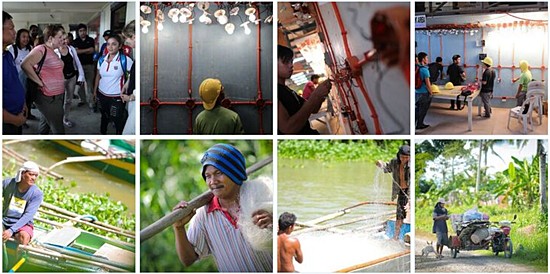
Save
the Children has reached nearly 900,000 people in its
comprehensive response. The children’s agency has vowed to
continue its rehabilitation assistance to some of the worst-hit
children and families. |
Two years after
Yolanda, Save the Children says ‘job is not yet over’
By Save the Children
November 6, 2015
Humanitarian agency vows continued rehabilitation support to children
and their families.
MAKATI CITY – Two years
after super typhoon Yolanda, Save the Children says ‘job is not yet
over’ and vows to continue its rehabilitation assistance to some of
the worst-affected children and families who are still reeling from
heavy loss of property and livelihoods. The super typhoon, which
struck on November 8, 2013, affected more than 14 million people,
including at least 5 million children, and left nearly 8,000 dead or
missing.
Save the Children Director, Ned Olney, said: “Clearly, the job is not
yet over. We knew from the start that this was going to be a long
process of rehabilitation. The world has not seen this kind of damage
from any typhoon in recent history. No media coverage can fully
describe what happened that harrowing day.”
Olney added: “Although tremendous effort has been put in to help
survivors, continued support is critical at this stage to ensure
Yolanda won’t leave a devastating legacy for thousands of families and
their children. Our worry is that families may no longer be able to
send their children to school and provide for their families once the
assistance stops. Improving livelihoods is essential for long term
recovery.”
Two years into the response, Save the Children has reached nearly
900,000 people, including half a million children in partnership with
communities, civil society, donors and the government. The children’s
agency has distributed families food and water; provided medicines and
primary health services through our mobile health clinics; repaired
classrooms, health facilities and water systems; and provided shelter
and livelihood assistance to farmers, fishermen and out-of-school
youth to help them provide for their families.
Felipe Malinao, 35, received assistance from Save the Children’s
livelihood program in Kananga, Leyte after the typhoon damaged his
crops and killed his livestock. Felipe used the livelihoods cash grant
to buy a carabao and three goats which he can use for farming and
selling. Felipe said: “I can use my carabao to plow and cultivate a
bigger area to plant my crops. When the time is ripe, I can barter the
male carabao I bought with a female so it could produce offspring that
I could share to my children.” Felipe shares that he hopes to use his
income to buy food and send his kids to school.
The children’s agency has provided skills training for out-of-school
youth so that they could find job or start up their own business.
Geovelyn, 21, enrolled in Save the Children funded welding program in
Tacloban after she quit school when her mother, 3 sisters and
relatives died during Yolanda. Jovelyn said: “I had to quit school to
be close to my family. I felt so guilty that I wasn’t able to do
anything for them since I was in another town that time.” After
finishing the program, Geovelyn got a job as staff at the same
training facility.
Moreover, Save the Children says that rehabilitation should not stop
at building homes and restoring livelihoods. To ensure welfare of
children in times of disaster, Save the Children is renewing the call
for the Congress and Senate to immediately pass the “Children’s
Emergency Relief and Protection Act” which calls for a comprehensive
plan to protect children’s rights before, during and after a disaster.
Olney said: “Children are always the most vulnerable when disasters
strike. If there is anything ‘Yolanda’ taught us all, it is that
improving protection for children before during and after emergencies
is essential to saving lives. Passing the child protection in
emergencies bill ensures that we learn from our experience to mitigate
the impact of future emergencies on children.”
|
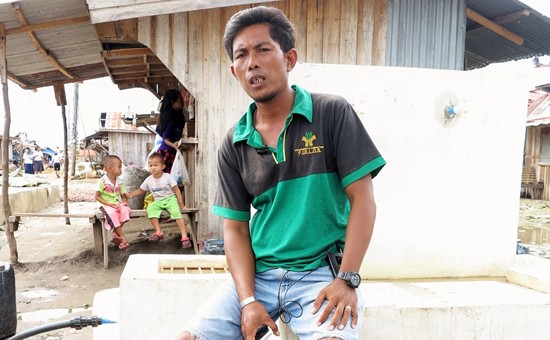
Alawie
Asid, whose displaced family now lives in the transition site in
Barangay Taluksangay, Zamboanga City, says the new tap stands
around their community – just like the one behind him – relieve
them from traveling to a remote area to fetch clean water.
(By
NC-ND / ICRC / R. Ang) |
Clean water for
4,000 people in Zamboanga
By ICRC
November 5, 2015
MANILA – A
community-based water-supply system providing potable water to over
4,000 people, including displaced families, was officially inaugurated
today in Barangay Taluksangay, Zamboanga City.
The project, supported by
the International Committee of the Red Cross (ICRC) and the village
and city authorities, is a long-term solution to the shortage of water
in this barangay (village), which hosts about 900 people displaced by
the armed fighting in 2013.
“Water was really scarce
here in Taluksangay. It was difficult. Now our lives are better –
people in the community no longer fight to get first in line. We can
easily get water. We don’t have to ride our banca (boat) anymore
because the water source is near,” said Alawi Asid, whose family was
displaced from Layag-Layag.
Clean water started flowing
from nine communal tap stands in September, reaching a total of 4,000
people in Taluksangay transition site, the nearby relocation site, and
the host community. More people stand to benefit as the water system
has the ability to cover additional localities in the barangay. Only
half of the capacity of the water source has been used so far.
The project was built by 80
displaced people who were employed in a cash-for-work programme, with
the ICRC providing materials and technical expertise. It was recently
handed over to the Taluksangay Water and Sanitation Association (TAWASA),
which was formed with ICRC support, and which will operate and
maintain the project. To help the TAWASA sustain the project, the ICRC
gave them tools, spare parts and office supplies.
“The ICRC went beyond the
engineering works, focusing also on community organization and
empowerment. The community took ownership of the project, and the
system is self-sustaining, making it able to last for years to come,”
explained Marcel Goyeneche, who heads the ICRC office in Zamboanga.
Since the armed clashes in
2013, the ICRC has stayed on with the Philippine Red Cross to support
thousands of displaced people in Zamboanga in speeding up their
recovery and improving their health and living conditions.
|
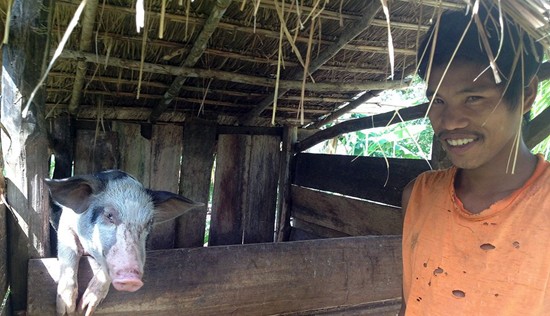
SJDB
livestock training: "We discovered a lot of ways to take good
care of our swine especially when they are infected with
diseases or when they are pregnant or lactating," says a
beneficiary from Barangay Hagbay in San Jose de Buan, Samar. (By
NC-ND / ICRC / R. Calera) |
Improving lives in
conflict-affected communities
By
ICRC
October 30, 2015
MANILA – In parts of Luzon and the Visayas, communities suffer from
the effects of a protracted armed conflict between government security
forces and the New People’s Army. Often living in remote and far-flung
areas, these communities also struggle with poverty, making everyday
life a challenge for them.
“Economic growth is often stunted in these communities, which also
suffer from the insecurity caused by sporadic clashes. Because of
this, they have limited access to income opportunities and, at times,
basic services too,” said Oualid Bech, head of the ICRC subdelegation
in Luzon and the Visayas.
As support to people suffering from the chronic effects of conflict
and poverty, the ICRC carries out programs that aim to help the most
vulnerable barangays (villages) and communities stand on their own
feet and become more resilient.
These programs employ a participatory approach wherein the
beneficiaries identify their own needs. A series of consultations and
discussions with the ICRC is therefore held to determine what kind
projects are suitable, and how to effectively implement and sustain
them.
All projects are monitored and evaluated through field visits by ICRC
staff with the support of volunteers from the Philippine Red Cross,
the ICRC’s primary partner in the country.
Creating opportunities
In the mountainous area of Guihulngan in Negros Oriental province,
corn is the staple food and main source of livelihood of the
communities. The farmers, however, had to travel to a distant town to
have their corn milled, spending considerable effort and money.
The farming community identified this as a challenge, and when the
ICRC stepped in to support, they proposed building a corn-milling
facility. In March, the corn mill began operating, and it has already
benefited farmers from seven barangays and improved the quality of
milling.
It has also opened up business and employment opportunities, as the
local association earns from every milling session and uses the income
to employ people to maintain the corn mill.
The association has earned over P65,000 since March 2015. The project
has also encouraged small farmers to utilize portions of their lots
for corn farming.
“When we heard that a corn mill would be built in our barangay, we
(residents) were very happy. Manual grinding is insufficient and
cannot accommodate us all. It also takes more than an hour to manually
grind 2.5 kg of corn, while machine-operated milling takes only 15
minutes,” recalled Segondo Cañafuego, a 53-year-old farmer and
resident of Barangay Planas in Guihulngan.
He added: “I am now planning to cover my farmland with corn because of
the machine operated mill here.”
Meanwhile in Negros Occidental, also in the Western Visayas, rice
farming is the primary source of livelihood. In 2015, the ICRC
supported local farmers’ associations in lowland barangays in Sipalay
with hand tractors and rice threshers, which increased the efficiency
of rice production. Like the corn mill in Guihulngan, these farm
machines provide extra income to their operators and the local
association.
For Lope de Vega, a fourth-class municipality in Northern Samar, the
devastation of abaca farms by bunchy top virus had a severe impact on
farmers’ livelihoods. Abaca is considered an important “cash crop” or
one that can easily be sold for its fiber. After assessing this need
with the community, the ICRC provided virus-resistant seedlings so the
residents could earn income from abaca again.
Helping themselves and the community
With the cash-for-work scheme, those identified as most vulnerable due
to lack of stable income – such as landless laborers and seasonal
farmers – will find temporary means to earn by working on projects
that also directly benefit their communities.
Unskilled workers are paid at least P250 a day, while skilled ones
receive slightly higher amounts. They usually have the opportunity to
work for 10-15 days.
These projects, which are chosen by the communities according to their
needs, are not labor-intensive and can thus involve women and the
elderly. In the municipalities of Juban and Gubat, Sorsogon, which
have interior or upland barangays where access can be difficult,
especially during rainy season, projects such as the clearing and/or
widening of barangay roads and building concrete pathways to water
sources were selected by communities through focus group discussions.
Other projects include vegetable gardens that benefit feeding programs
for children, repair of churches, construction of school fences,
barangay meeting places, and compost pits. In the majority of these
projects, the barangays provide the materials and play key roles in
overseeing their implementation.
Though temporary, the cash-for-work program provided income to 616
people in 11 barangays in Juban and Gubat in July and October.
These programs show that, by using an approach that engages the
community, its people become more resilient and better equipped to
rise to future challenges.
◄◄home
I
next►►